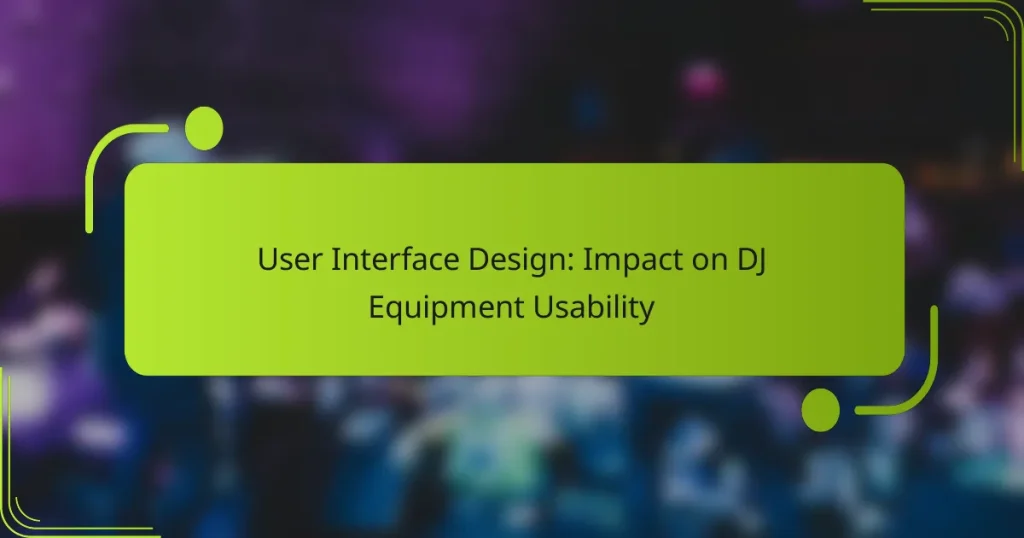User interface design plays a crucial role in the usability of DJ equipment, directly affecting how DJs interact with their devices during performances. A thoughtfully crafted interface can enhance workflow efficiency, boost user confidence, and facilitate seamless operation, ultimately leading to a more engaging experience for both the DJ and the audience.

How does user interface design affect DJ equipment usability?
User interface design significantly impacts the usability of DJ equipment by influencing how easily a DJ can interact with the device. A well-designed interface can streamline performance, enhance user confidence, and improve overall workflow efficiency.
Intuitive controls enhance performance
Intuitive controls are crucial for DJs, as they allow for quick adjustments without interrupting the flow of a set. When buttons, knobs, and sliders are logically arranged and labeled, DJs can make changes rapidly, which is essential during live performances. For instance, having volume controls easily accessible can prevent awkward pauses and maintain audience engagement.
To achieve intuitive controls, designers should prioritize familiar layouts and tactile feedback. Controls that mimic common instruments or software can reduce the learning curve, allowing DJs to focus on creativity rather than operation. Testing with actual users can reveal which configurations feel most natural.
Visual feedback improves user confidence
Visual feedback, such as LED indicators and screen displays, plays a vital role in enhancing a DJ’s confidence during performances. Clear visual cues help DJs monitor levels, track progress, and make informed decisions in real-time. For example, color-coded lights can indicate whether a track is playing or paused, reducing the chance of errors.
To maximize the effectiveness of visual feedback, designers should ensure that displays are bright, legible, and easily interpretable from a distance. Incorporating customizable settings allows DJs to tailor feedback to their preferences, further boosting their confidence and performance quality.
Layout impacts workflow efficiency
The layout of DJ equipment directly affects workflow efficiency by determining how quickly a DJ can access essential functions. A well-organized interface minimizes unnecessary movements and allows for seamless transitions between tasks. For instance, placing frequently used controls within easy reach can significantly speed up the mixing process.
When designing layouts, consider the natural flow of a DJ’s performance. Grouping related functions together, such as effects controls and EQ settings, can streamline the workflow. Additionally, providing ample space between controls can prevent accidental adjustments, ensuring that the DJ maintains full control over their set.

What are the best practices for designing user interfaces in DJ equipment?
Effective user interface design in DJ equipment focuses on enhancing usability and ensuring intuitive operation. Key practices include maintaining consistency in control placement, clear labeling of functions, and implementing responsive designs for touch interfaces.
Consistency in control placement
Consistency in control placement is crucial for allowing DJs to operate equipment efficiently without looking away from their performance. Controls should be arranged in a predictable manner, often following a layout that mirrors common industry standards.
For example, placing volume knobs and EQ controls in similar positions across different devices helps users quickly adapt to new equipment. This familiarity reduces the learning curve and minimizes the risk of errors during live performances.
Clear labeling of functions
Clear labeling of functions is essential for quick recognition and operation of controls. Labels should be legible, using a font size that is easy to read under various lighting conditions typical in DJ environments.
Using icons alongside text can enhance understanding, especially for complex functions. For instance, a play button should be universally recognizable, helping DJs to identify controls at a glance, which is vital during high-energy performances.
Responsive design for touch interfaces
Responsive design for touch interfaces ensures that users can interact with screens seamlessly, regardless of the device’s size or orientation. Touch controls should be large enough to prevent accidental activation, with sufficient spacing between them.
Additionally, feedback mechanisms such as visual or haptic responses can enhance user experience by confirming actions. For example, a slight vibration when a button is pressed can reassure DJs that their input has been registered, which is particularly useful in loud environments.

Which DJ equipment brands prioritize user interface design?
Several DJ equipment brands focus on user interface design to enhance usability and performance. Pioneer DJ, Numark, and Denon DJ are notable for their commitment to intuitive controls and user-friendly layouts, making them popular choices among DJs.
Pioneer DJ
Pioneer DJ is renowned for its emphasis on user interface design, particularly in its flagship products like the CDJ and DJM series. These devices feature large, responsive screens and well-organized layouts that allow DJs to navigate tracks and settings quickly. The intuitive design reduces the learning curve for both beginners and seasoned professionals.
Key features include color-coded waveforms and customizable layouts, which help DJs visualize their mixes effectively. When choosing Pioneer DJ equipment, consider how the interface aligns with your mixing style and preferences.
Numark
Numark prioritizes user interface design by offering equipment that is accessible and straightforward. Models like the Mixtrack series come with large jog wheels and clearly labeled controls, making it easy for users to engage with the software and hardware. This focus on simplicity is ideal for beginner DJs who need to learn quickly.
Additionally, Numark often integrates visual feedback elements, such as LED indicators, which enhance usability during live performances. When selecting Numark gear, look for features that suit your performance needs and comfort level with technology.
Denon DJ
Denon DJ stands out for its innovative user interface design, particularly in its Prime series. These devices incorporate touchscreens and customizable layouts that allow DJs to tailor their experience. The interface is designed to minimize distractions, enabling DJs to focus on their performance.
Denon DJ also emphasizes seamless integration with various software platforms, providing a cohesive user experience. When considering Denon DJ equipment, evaluate how the interface can enhance your workflow and overall performance efficiency.

What are common usability issues in DJ equipment interfaces?
Common usability issues in DJ equipment interfaces include overly complex menus, poor tactile feedback, and inconsistent visual elements. These problems can hinder a DJ’s ability to perform effectively, leading to frustration and potential performance errors.
Overly complex menus
Overly complex menus can overwhelm users, making it difficult to access essential features quickly. When menus are cluttered with too many options or require multiple steps to navigate, DJs may waste valuable time during performances. A streamlined menu structure with clear categories and quick access to frequently used functions is crucial.
To improve usability, consider using a hierarchical menu design that allows for easy navigation. Limit the number of options displayed at once and implement shortcuts for key functions. This approach can enhance efficiency and reduce cognitive load during live sets.
Poor tactile feedback
Poor tactile feedback in DJ equipment can lead to uncertainty about whether a control has been activated. If knobs, buttons, or faders lack distinct physical responses, DJs may struggle to make precise adjustments while performing. Effective tactile feedback helps ensure that actions are confirmed without needing to visually check the interface.
To enhance tactile feedback, choose equipment with well-designed controls that provide clear resistance or click sensations. Testing different models can help identify which devices offer the best physical responses for your style of performance.
Inconsistent visual elements
Inconsistent visual elements can confuse users and disrupt workflow. If different parts of the interface use varying colors, fonts, or icon styles, it can be challenging for DJs to quickly identify functions. A cohesive visual design helps users understand the layout and functionality of the equipment at a glance.
To maintain consistency, establish a unified design language across all interface elements. Use similar colors for related functions and ensure that icons are easily recognizable. Regularly reviewing and updating the interface based on user feedback can also help maintain clarity and usability.

How can user testing improve DJ equipment interfaces?
User testing enhances DJ equipment interfaces by providing insights directly from the end-users, which leads to more intuitive designs. By observing how professional DJs interact with the equipment, designers can identify pain points and areas for improvement, ultimately increasing usability and performance.
Gathering feedback from professional DJs
Engaging professional DJs in the design process is crucial for gathering relevant feedback. Their expertise allows them to identify specific features that enhance or hinder usability, such as button placement, screen readability, and overall workflow efficiency.
To effectively gather feedback, consider conducting focus groups or one-on-one interviews. Utilize surveys to quantify preferences and pain points, ensuring that the feedback is comprehensive and actionable.
Iterative design based on user experience
Iterative design involves continuously refining the interface based on user feedback. After initial testing, designers should implement changes and conduct further tests to evaluate the effectiveness of those modifications.
Establish a cycle of prototyping, testing, and revising. This process can include low-fidelity wireframes for early-stage concepts and high-fidelity prototypes for final testing. Aim for multiple rounds of testing to ensure that the design meets the needs of DJs across various skill levels.

What role does accessibility play in DJ equipment design?
Accessibility is crucial in DJ equipment design as it ensures that all users, regardless of their physical abilities, can effectively operate the gear. By incorporating accessible features, manufacturers can enhance usability and broaden the audience for their products.
Inclusive design for diverse users
Inclusive design focuses on creating DJ equipment that accommodates a wide range of users, including those with disabilities. This can involve tactile controls, visual indicators, and auditory feedback to assist users with various needs. For example, color-blind-friendly interfaces and adjustable control layouts can significantly improve the experience for many DJs.
Implementing inclusive design principles not only helps users with disabilities but also benefits all DJs by providing more intuitive and user-friendly interfaces. This approach can lead to increased creativity and performance quality, as users feel more comfortable and confident with the equipment.
Adjustable settings for different abilities
Adjustable settings allow DJs to tailor equipment to their specific needs, enhancing usability for individuals with varying abilities. Features such as customizable button sizes, adjustable sensitivity for touch controls, and the ability to change visual displays can make a significant difference. For instance, a DJ with limited dexterity may benefit from larger buttons and simplified layouts.
When designing adjustable settings, consider providing clear instructions and intuitive interfaces to facilitate easy modifications. This empowers users to optimize their equipment for their unique requirements, ultimately leading to a more enjoyable and effective DJing experience.

What emerging trends are shaping DJ equipment user interfaces?
Emerging trends in DJ equipment user interfaces focus on enhancing usability through intuitive design, touch interfaces, and integration with software. These advancements aim to streamline the DJing process, making it more accessible for both beginners and professionals.
Touchscreen Interfaces
Touchscreen interfaces are becoming increasingly popular in DJ equipment, allowing for more direct interaction with software features. These interfaces provide visual feedback and enable gestures like swiping and pinching, which can enhance the user experience. DJs can quickly access effects, loops, and samples, reducing the time spent navigating menus.
When considering touchscreen interfaces, it’s essential to evaluate the screen size and resolution. Larger screens with high resolution can display more information clearly, making it easier to mix tracks effectively. However, they may also increase the equipment’s weight and cost.
Integration with Mobile Apps
Integration with mobile apps is another significant trend, allowing DJs to control their equipment remotely and access a wider range of features. Many modern DJ systems now offer companion apps that provide additional functionalities, such as track management and live performance tools. This integration can enhance creativity and flexibility during performances.
When choosing DJ equipment with app integration, consider the compatibility with your preferred devices and the app’s user interface. A well-designed app can significantly improve your workflow, while a poorly designed one may complicate your setup.
Customizable User Interfaces
Customizable user interfaces allow DJs to tailor their equipment to their specific needs, enhancing usability. Many devices now offer options to rearrange controls, change color schemes, and create personalized layouts. This flexibility can help DJs work more efficiently and comfortably.
To maximize the benefits of customizable interfaces, take time to explore the settings and experiment with different configurations. Avoid overwhelming yourself with too many options; focus on the features that matter most to your style of mixing.


